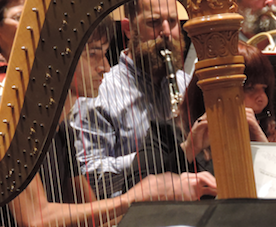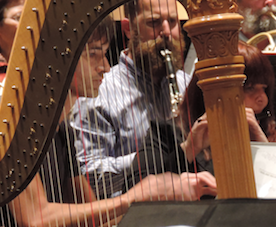
Photo by Be'eri Moalem
The three pieces on Saturday night’s concert of the Cabrillo Festival of Contemporary Music, at the Santa Cruz Civic Auditorium, all featured a common thread. Sean Friar’s Noise Gate (2013) was about hiking away from the noise of the city and experiencing the subtle sounds of nature. Thomas Newman’s It Got Dark (2009) leaves the same city (Los Angeles) but travels in time rather than location, in a nostalgic visit to the gentler world that was there before the bustling metropolis hustled in. Mason Bates’ Alternative Energy (2012) also traveled in time and space, imagining energy generation in the past, present, future, and the distant future, and also contrasting intense industrial sounds with the serene sounds of nature. Urban vs. natural — present vs. past — tension vs. resolution: It is the same basic dichotomy that runs through all music, akin to dominant vs. tonic.
Yet all three approaches had different styles and personalities. Noise Gate was the most abstract of the three. It began at the center of urban grit with quarter-tone-clustered brass screeching like semitrailers on the freeway and percussion thumping like jackhammers. As the narrative floats away from the city, the sounds gradually vanish until we are left with just a distant rumbling and humming. Finally, we hear silence. But no sooner do we get to enjoy this respite than a different set of sounds creeps in: insects, birds, wind. Friar sets the sounds of nature in fantastic wisps of harmonic clusters in ultrahigh strings and in abstract flutters from various corners of the orchestra. At the heart of the piece were amazing bird-call imitations, played artfully by the woodwind section. Although the title Noise Gate refers to an electronic music concept for volume threshold, this was the only piece in the concert that did not employ electronic effects.
It Got Dark was the most traditionally tonal piece on the program. Newman comes from a line of famous musicians and has worked as a film composer since the 1990s, receiving 11 Oscar nominations. He wrote the music for dozens of movies, including The Shawshank Redemption, The Green Mile, Erin Brockovich, American Beauty, Finding Nemo, and WALL-E. Concert music and movie music are two different animals — so the cinematic quality of Newman’s music is undeniable.
Friar sets the sounds of nature in fantastic wisps of harmonic clusters in ultrahigh strings and in abstract flutters from various corners.
Long unobtrusive melodies, looping progressions, and occasional dramatic flares were aided in his piece by prerecorded voiceovers and a glossy handout for each audience member with pictures of old Los Angeles on which each movement was based. (The pictures could also have been presented as a projected slide show, but that might have been too obtrusive.) Newman decided not to take the opportunity to explore music without images and spoken words, instead presenting us with an experience that lay somewhere between a concert and a movie.
The Kronos Quartet was featured as a soloist group, but I have never heard them make less of an impact. Usually they are the star attraction, but in It Got Dark they were a part of the orchestra — this wasn’t really a concerto for quartet and orchestra, though they did play more-intricate lines. Kronos always performs with amplification; it’s their signature sound. Hearing them alongside an unamplified orchestra underscored the advantages and disadvantages of amplification. The orchestra sounded warm and rich, and the quartet nasal and tinny — the price they pay for volume, clarity, and immediacy provided by the amplification.
Bates finds the perfect balance between innovative complexity and speaking in the idiom of our time.
Alternative Energy was by far the most interesting and entertaining piece on the program, maybe even more so than any other 21st-century composition I have heard. Bates finds the perfect balance between innovative complexity and speaking in the idiom of our time. For too long, academic composers scared audiences away by neglecting to find that balance, resulting in a common fear of contemporary music. The Cabrillo Festival counters that perception with open-mindedness and enthusiasm. While Bates is unafraid to use dissonance, quartertones, and “unpleasant” sounds all over the place, he also brings in jazzy melodies, hip-hop beats, and fiddle tunes, performed by Concertmaster Justin Bruns in some of the most evocative playing of the evening. Bates sat right under the timpani at the laptop controls, triggering sound effects that sounded like fire sparks and steam puffs — daily atmospheric noises, here sampled and arranged into strong rhythmic patterns for fantastic effect.
Alternative Energy’s four attacca movements led to each other seamlessly, and the programmatic description could clearly be followed, from the beginnings of the industrial revolution with hand-cranked engine starters to a nuclear power plant, a particle collider, and finally a return to nature in a postglobal, warming, tropical jungle in Iceland, where inner spiritual energy is generated.

